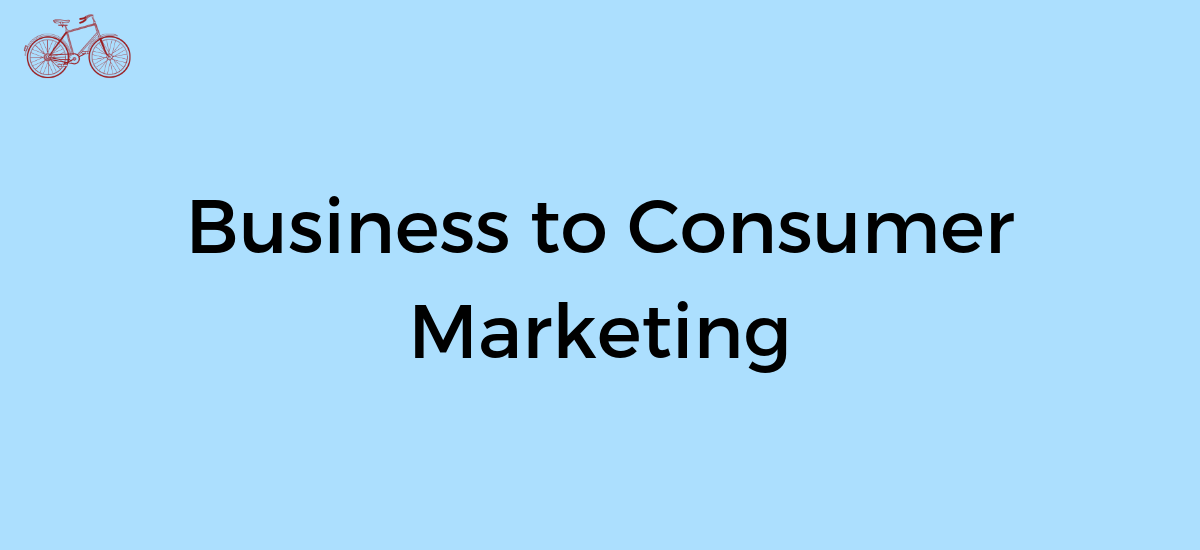Consumer marketing is competitive. It’s complex. It moves fast. It deals with human psychology.
All of this forms the topic of business to consumer marketing. An area of marketing that needs its own understanding. Its own marketing concepts and strategies. These strategies allow us to create better consumer products and improve our marketing of those products.
Here, we will discuss an overview of the concept of business to consumer marketing.
What is Business to Consumer Marketing?
Business to consumer (B2C) marketing is the marketing and sale of products to end consumers. This is a process, which differs from B2B marketing, in that the purchaser of the product is the user of that product.
Purchases tend to be relatively small quantities, relatively low costs, and decisions happen within relatively short time periods. It could be anywhere from instant to weeks. These attributes require us to look at B2C marketing as its own discipline, characteristics, components, and strategies.
To fully understand B2C marketing, we need to make a number of considerations. Which, we will continue to discuss below.
Characteristics of B2C Marketing
To understand why we need to consider business to consumer marketing as its own discipline, we need to understand what makes it unique. These are its characteristics.
B2C characteristics involve things like specific targeting requirements, purchase decisions based on many psychological factors, and extreme price sensitivity. Just to name a few. But, we will look at many of the characteristics of B2C marketing below. The following are some of the key characteristics to consider.
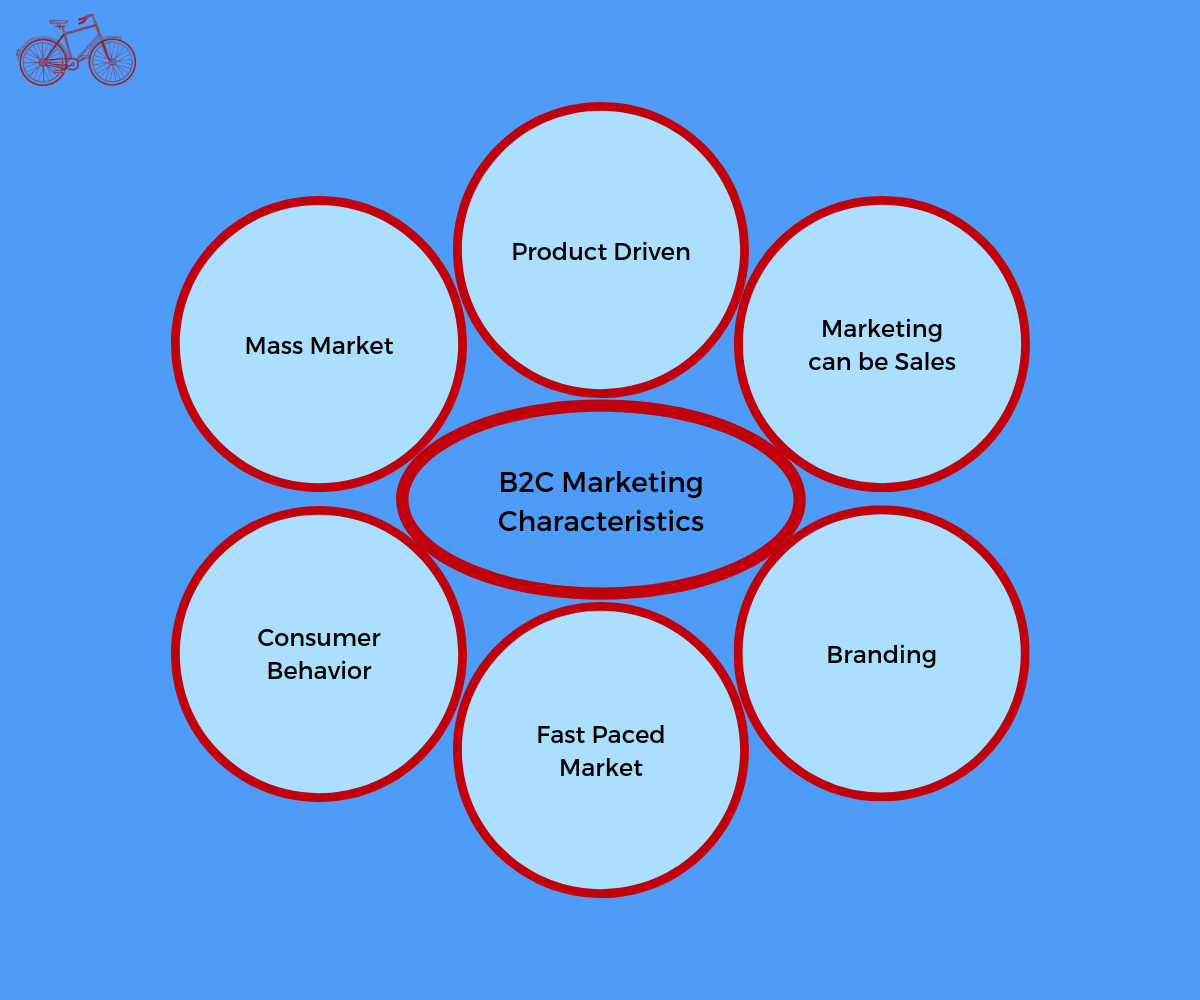
Mass Market
B2C marketing has the characteristic of being mass market. As the volume of potential consumers is high, it provides huge market size potential.
Not all consumer marketing needs to be mass market. But, this is a characteristic to consider. It requires a strategic decision. That decision being whether to go mass market or niche.
Product Driven
Consumer marketing is primarily product focused. That means the product tends to be more important than the company. New products need to be created regularly. The design and product itself have to generate marketing and demand.
Consumer marketers need to be product driven.
Marketing can be Sales
In B2C marketing, marketing is primarily the sales driver. This is both from a messaging perspective and a marketing channel perspective.
Meaning, the copy that is used in messaging is sales language. Directed at generating action, not necessarily interest. Then, the channels that are used are structured to generate a purchase almost immediately. That means shelf space and how and where products are advertised.
All of this is evidence that marketing is primarily responsible for sales in B2C marketing.
Consumer Behavior
Consumer behavior plays a critical role in business to consumer marketing. It’s basic human psychology. It is understanding how humans think and make purchases. Unlike B2B purchases, it’s not entirely logical. There are many factors other than price and ability to generate profit.
In B2C marketing, we have to understand many other consumer behaviors. Like status, cost, enjoyment, perceived value, acceptance by a peer group, and others. All of these behaviors require a deeper understanding that is unique to the consumer market.
Fast Paced Market
The consumer market changes with the seasons. In apparel, there are new fashion trends each season and each year. In consumer products, new products are launched for each holiday season.
Understanding that consumer tastes change quickly, means we need to be product driven. And, our company has to move quickly with the speed of the consumer market.
Branding
Branding in the consumer market is highly important. It provides the company a way to tell a story. It gives the opportunity to build a relationship with consumers. It is how loyalty is built. When a customer can see themselves identifying with your company and brand, they are more likely to purchase.
Again, since consumers have far more psychological factors than profit and price in their purchase decisions, there are many more intangibles when it comes to our consumer marketing.
These are a few of the key characteristics of business to consumer marketing. There are many nuances to consider when marketing to consumers. To get started in your marketing efforts, this is a good place to begin.
B2C Marketing Framework
The next topic to consider in our consumer marketing efforts is the marketing framework for our B2C customers. This becomes the foundation for our marketing plan and marketing strategies.
The framework for B2C marketing has some core components, which we will take a look at below. The following is the framework we should consider.
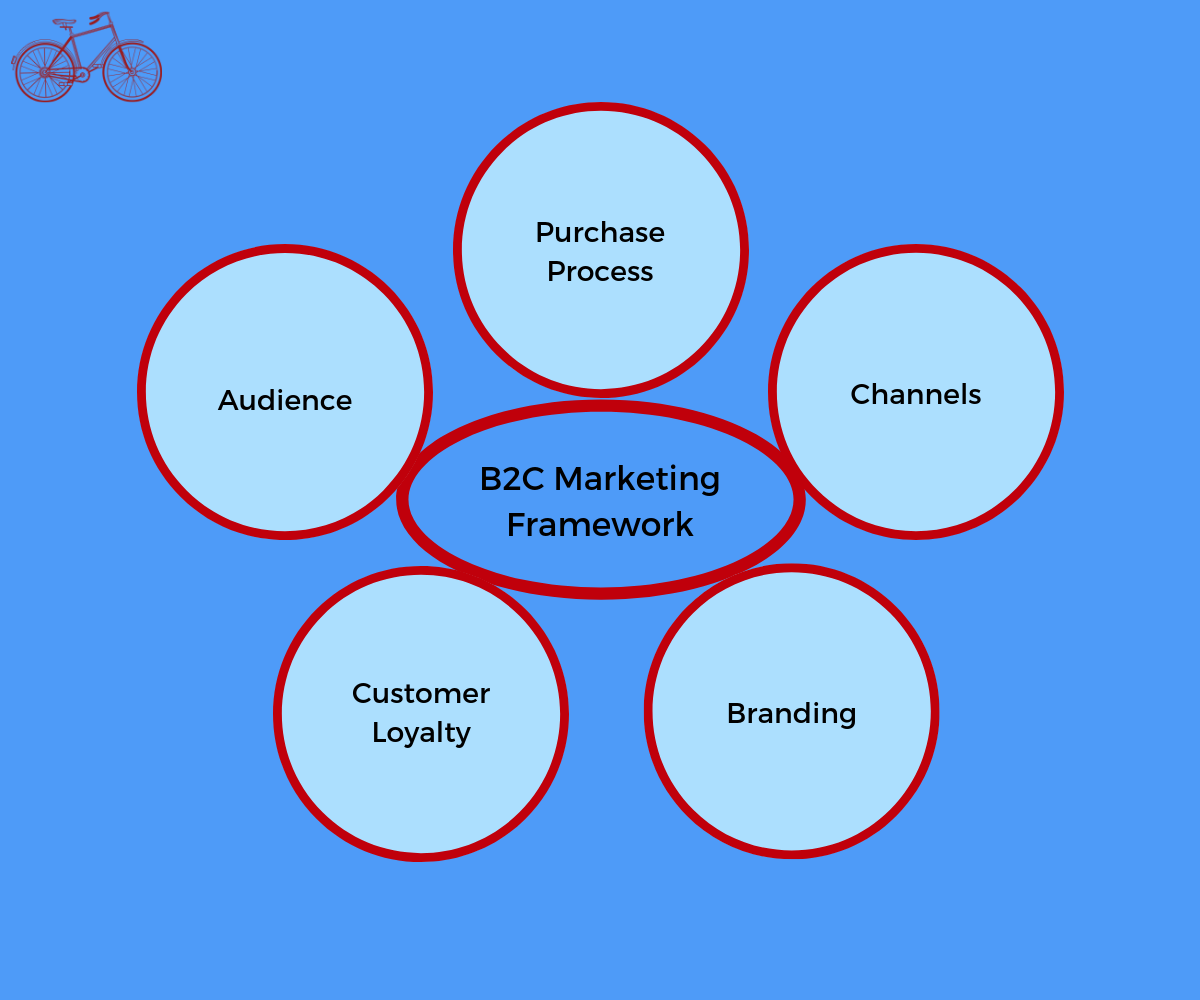
Audience
In any marketing process, the first step is always the audience. You need to know who to build your product for and who to market to. This becomes the foundation for the B2C marketing framework.
Starting with the audience, then developing everything from this component.
Purchase Process
The next piece of the framework is the purchase process. This is identifying how a purchase is made. Then, matching the process to the customers’ existing expectations to purchase. This requires building a model that either reflects in-store purchases, online purchasing, and where customers will perform their research.
The purchase process requires a company to understand their customers and create processes to match their customers’ expectations.
Channels
Deciding how to communicate and distribute products is the next component of the B2C marketing framework. The channels you choose should be decided based on where your customers are. Their location, where they go to hear about products, and where they purchase products.
It encompasses all the considerations you need to make with regards to getting your products in front of your audience.
Customer Loyalty
Loyalty is a big concern in consumer marketing. As purchases tend to be transactional, how you build loyalty into products will determine how many times a customer will repeat purchase. These repeat purchases are how companies can create predictable revenue and sales.
Customer loyalty is the part of the framework that creates repeat customers.
Branding
Branding is a critical aspect in consumer marketing. This is how a product or company tells a story their customer identifies with. This identifying has an impact on sales, loyalty, and the perception of the company.
Branding is part of the framework as it impacts many strategic decisions.
The B2C marketing framework provides a foundation of considerations that can be used to create a marketing plan. These are based on the marketing mix and the characteristics that make B2C marketing unique. Take this framework and you can use it as a starting point for your marketing plan.
Common B2C Marketing Channels
As we look at our B2C marketing, another consideration we will inevitably need to make is what channels to use. This is how we communicate and distribute our products. And, it needs to match where our customers are and what they expect.
We have many channels to choose from. It makes sense to take a look at some of the more common channels as we build out our consumer marketing strategy. The following are some common B2C marketing channels.
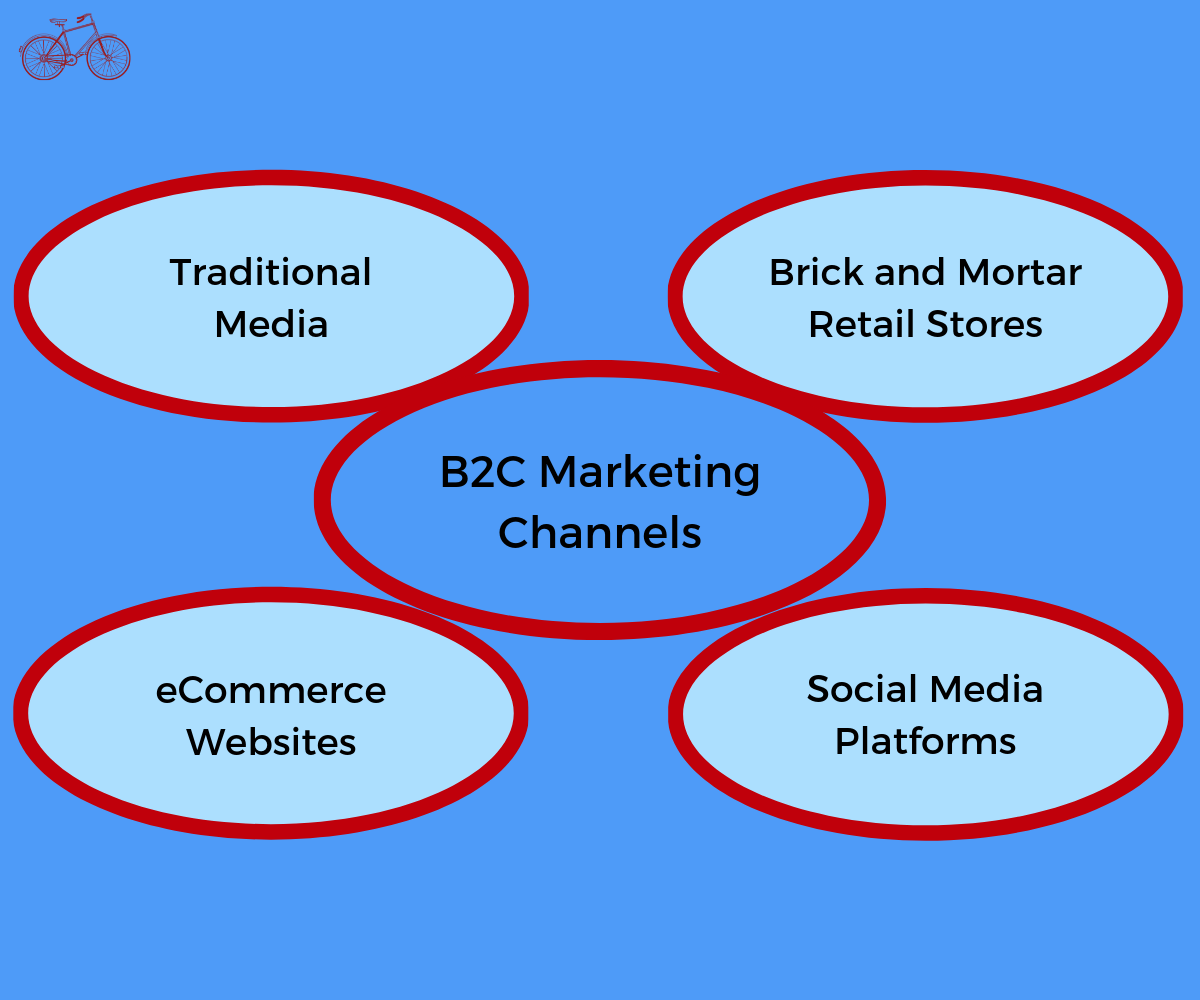
Traditional Media
Traditional media, which is the first channel we will look at, is a communication channel we can consider. Traditional media can be considered radio, television, print, and direct mail. All the marketing channels that have become popular prior to internet based channels.
Depending on the audience, this can be an effective communication channel to consider.
Brick and Mortar Retail Stores
Brick and mortar retail locations is a distribution channel we should consider. Whether through a retailer, shopping mall, or a company owned store, it is one purchase channel that dominates consumer purchases.
Brick and mortar is a traditional channel and the majority of consumer purchases still occur in a brick and mortar location.
eCommerce Websites
eCommerce is another channel at our disposal to distribute our consumer products. More purchases are occurring online. ECommerce websites make it easier for consumers to purchase products. Thus, it can be an excellent channel to use.
An eCommerce website can include your own company website. Retailers that have websites. Even marketplaces like Amazon. These are all options for using eCommerce as a consumer channel.
Social Media Platforms
Consumer marketing can have a great impact on social media platforms. They offer great targeting options, ways to engage with consumers, and the ability to create two-way conversations.
This makes social media an excellent communication channel for B2C marketing.
These are just a few of the common channels we can use in our consumer marketing. Each category above has sub-categories, and there are many options within each. Taking this as an overview can help create that foundation for deciding which channels are right for your business.
Common B2C Marketing Strategies
As we understand the landscape of B2C marketing better, it is time to take a look at some of the common strategies at our disposal. Strategies are the overarching decisions we make about our brand. They determine how we want to position ourselves in the market. It makes sense to look at the positioning level strategies that are most common.
Here, we are discussing our overall strategies. Then, we can apply more strategies and various tactics to execute our overall strategies. The following are some common B2C marketing strategies.
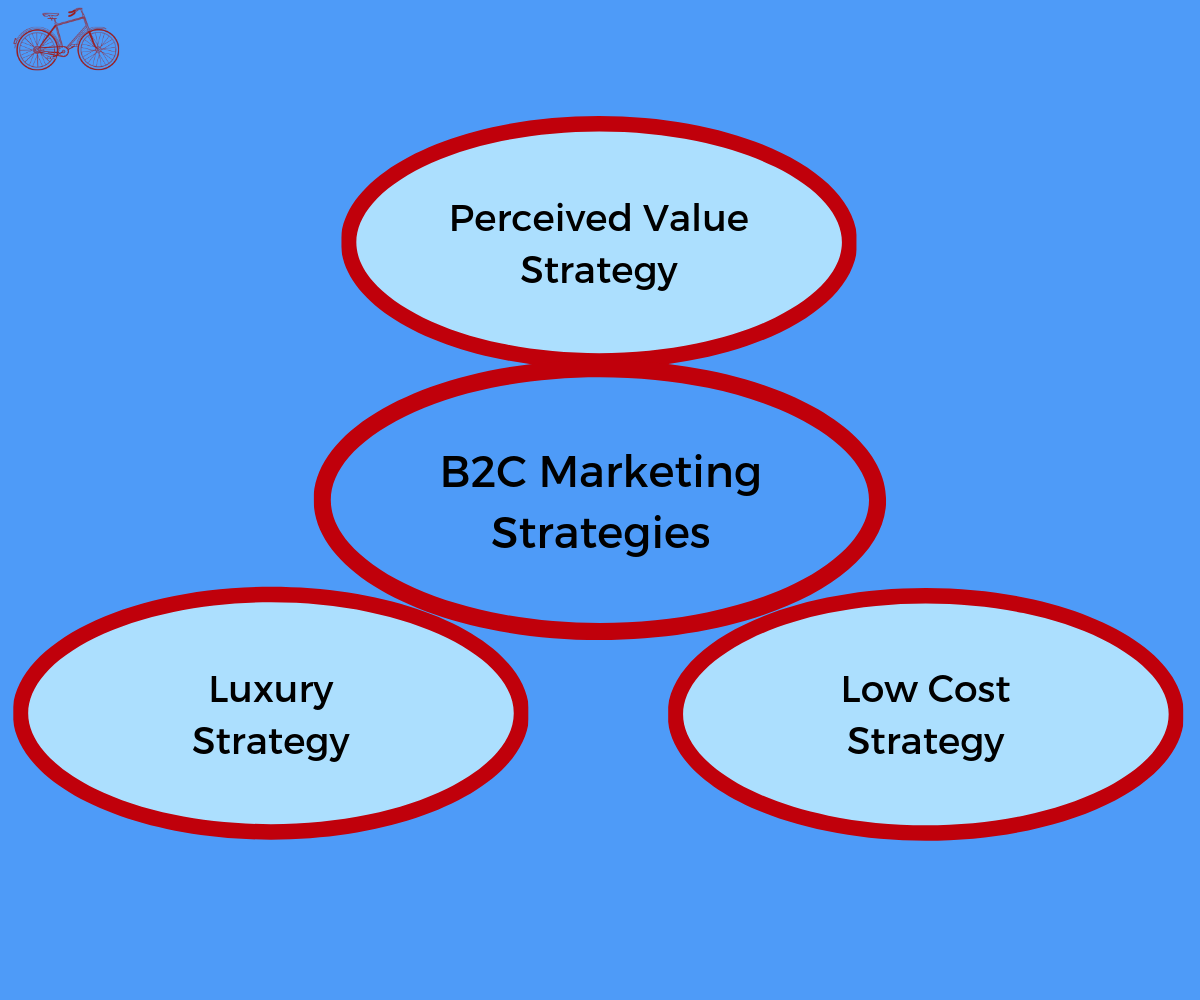
Perceived Value Strategy
The first strategy we will discuss is the perceived value strategy. Often associated with pricing, this strategy has a goal of leaving customers with high perceived value. It is such that they believe they underpaid for your product.
This is a strategy that tries to target value conscious shoppers. Not necessarily shoppers looking for the lowest price.
Luxury Strategy
The luxury strategy is about offering luxury goods. Usually this strategy uses strong branding. Using a consumer’s desire to be accepted by a peer group. It is used as a status symbol. Typically, this strategy commands a high price for the product.
The luxury strategy should be employed if you are looking to be a considered a luxury good.
Low Cost Strategy
The low-cost strategy is a strategy where you aim to always be the cheapest. This works well with products which are commodities. Also, this works well when you are targeting a price sensitive audience, or if you are trying to compete with a strong brand.
There are many ways to use the low-cost strategy, and you need to decide if this is the strategy you would like to take.
These are just a few of the strategies you can use in consumer marketing. Deciding which one to use can be difficult. Like anything, determine your objectives and goals, then determine your strategy. There are many more strategies you can choose from. These few should get you started and you can build from there.
B2C Marketing Plan Components
Now that we have gone through all the different components of B2C marketing, it is time to take a look at our marketing plan. Everything has been leading to this point. The point where we can put all of our learnings into an actionable plan.
Let’s take a look at what that plan should consist of. Our B2C marketing plan should have some key components. Obviously, you can increase the number of areas you would like to focus on. The following are some of the key components of a B2C marketing plan.
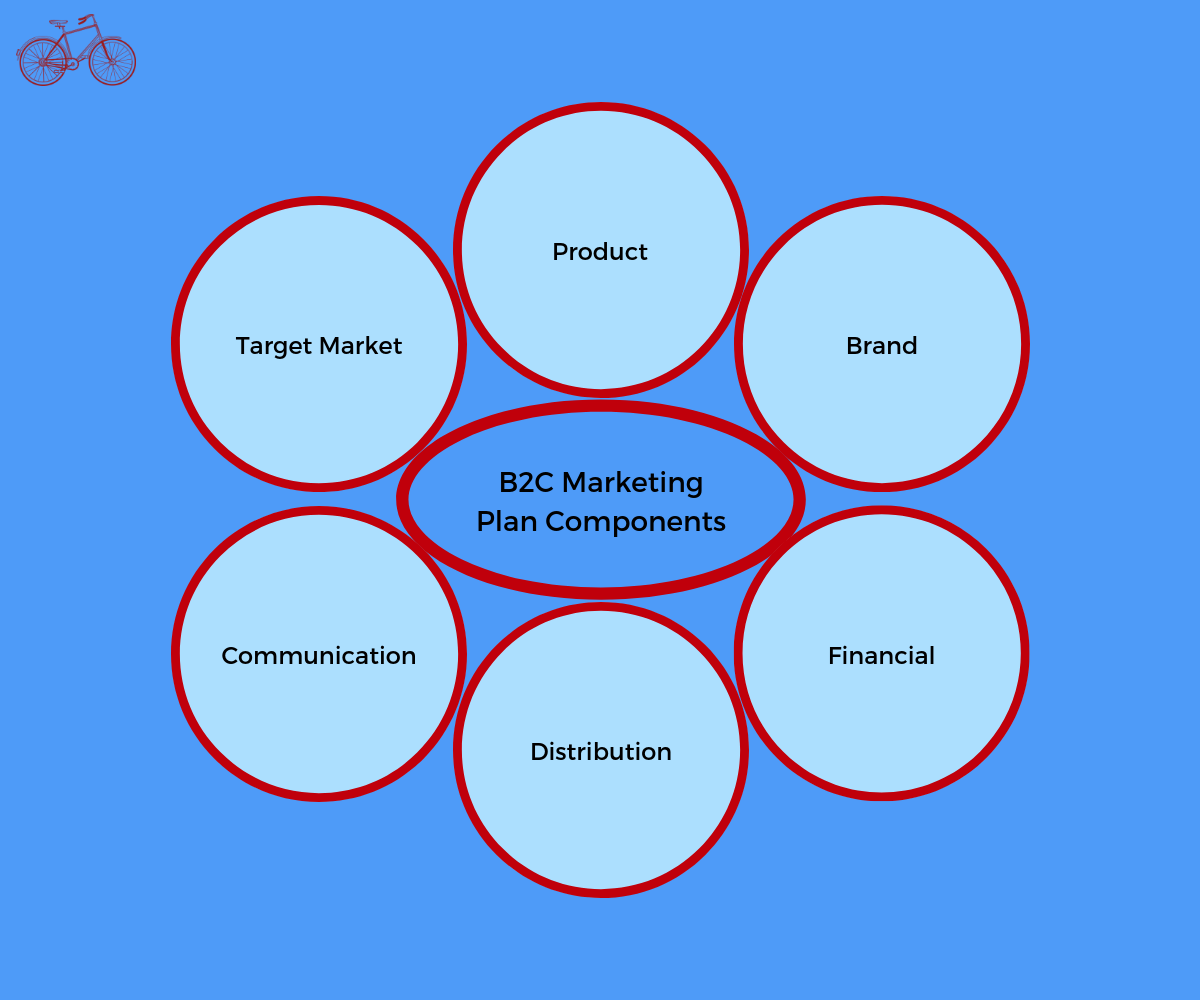
Target Market
The first component we need to detail is our target market. Understanding specifically who we want to market to. Who we want to build our product for. Who will be purchasing the product.
Once this is detailed, we can build the other parts of our plan.
Product
The next area of our marketing plan is the product. Detailing the product and everything about the product, which determines all the next areas of the plan.
Ultimately, the product is what we sell, how we solve our markets problems, and generate revenue. This has to be a key component of our marketing plan.
Brand
How do we want our market to perceive our product? This is the decision we need to make about what we want our product to say. It is the story and the personality behind our product. It becomes how our target market identifies with our product.
In consumer marketing, this is the component of our marketing plan where we create a persona that our market can identify with.
Communication
The communication component of our marketing plan is how we are going to communicate with our customers. Not only how we will communicate, but what we will communicate. This section will include messaging, channels we would like to use, and various other components of communication.
This is the section we will use to determine how we make potential customers aware. And how we will communicate to existing customers.
Distribution
Distribution is all about where we will put our products so that they are in the most convenient place for our target market to purchase. For marketing, placing the product in the location that the customer expects it to be, and where it is convenient to purchase, can be how it gets purchased at all.
The distribution section is how we plan and strategize how to get our products in front of our target market.
Financial
The final component that is essential is the financial section of marketing. This is how much our marketing will cost, what the results will be, and how much we should invest in it. This is a critical stage, because our profitability will depend on accurate projections.
These are some of the key components of a business to consumer marketing plan. There are more extensive inclusions we can, and possibly should make. Addressing these key areas will get the foundation for a solid marketing plan started.
Business to consumer marketing is a huge market. It has specific characteristics. It takes specific plans, strategies, and tactics. Understanding this area of marketing, especially if you will be marketing to consumers, can help determine what strategies you should use. Use this overview to get a foundational understanding. Then, further your knowledge to execute a sound marketing strategy.
